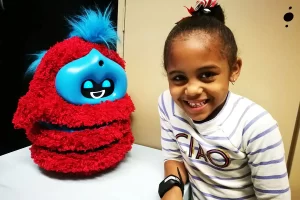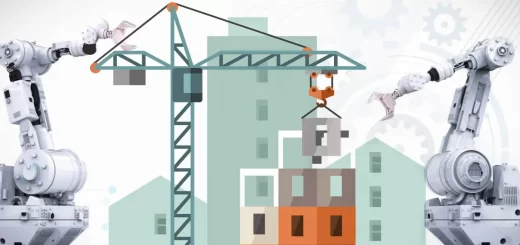Tega robot review, features, advantages, disadvantages and What can Tega do?
Tega is designed to be a long-term companion for students, particularly in early literacy education. It can engage children in storytelling sessions, reading stories aloud, and asking questions to assess their comprehension.
Tega robot in Education
Tega isn’t just a talking robot; it uses a smartphone to display facial expressions that change based on the interaction with the student. This can make learning and interaction more engaging for children, especially younger ones, as they can better understand Tega’s reactions and emotions. Tega robots represent an exciting potential tool for making education more interactive, personalized, and engaging, especially for younger students.
Tega is designed with younger students in mind, particularly for developing language and literacy skills. It can tell stories, ask questions based on the student’s responses, and adapt its teaching style to the child’s progress. The effectiveness of Tega robots would depend on the age and developmental level of the students.
Tega uses software that can detect a student’s emotions through facial expressions. This information can be used to tailor the robot’s responses, offering encouragement when a student seems frustrated or celebrating success together.
Tega can be programmed to emphasize the value of effort and perseverance, promoting a growth mindset in students. This means encouraging them to view challenges as opportunities to learn and grow. Tega excels at using storytelling to teach. Imagine a robot companion who can read stories, ask questions about the plot, and create new stories together with the student!
Tega isn’t just programmed with knowledge, it can also be a storytelling companion. Researchers have explored using Tega to read stories to children and assess their comprehension through their responses. Tega can understand a child’s emotions through facial recognition software. This allows Tega to tailor its responses and learning approach to keep the child engaged and motivated.
Tega isn’t meant to replace teachers, but rather act as a supportive learning buddy. It can celebrate successes, offer encouragement, and share in a child’s frustration – all to make learning more enjoyable. Tega’s development is heavily focused on aiding young children in their early literacy stages. This includes building vocabulary, and comprehension skills, and fostering a love for learning.
Tega can be used to promote a “growth mindset” in students. This means encouraging them to believe their abilities can improve with effort, a valuable attitude for young learners. Unlike some cold, metallic robots, Tega has a soft body, making it more approachable and huggable for young children. This can create a more positive and comfortable learning environment.
Advantages of Tega Robots in Schools
Tega robots could be used to make learning more interactive and engaging for students. This could help students to retain information better and develop a love of learning. Tega robots could be used to provide students with personalized learning experiences. The robots could tailor their instruction to the individual needs of each student.
Working with Tega robots could help students to develop important STEM (science, technology, engineering, and mathematics) skills. These skills are in high demand in the workforce. Tega robots could be used to help students develop social and emotional skills. the robots could be used to teach students about empathy and cooperation.
Tega robots could act as interactive tutors or assistants, personalizing learning experiences for students. Tega robots could be designed to assist students with disabilities, providing physical or educational support. A robot companion could make learning more fun and engaging, motivating students who may struggle with traditional classroom settings.
Tega robots could be programmed to help students develop social and emotional skills through interaction and play. Tega uses special software to read a child’s facial expressions! This allows the robot to tailor its responses to the student’s mood and engagement level, making the learning experience more dynamic.
Tega robots could make learning more interactive and engaging for students, especially in subjects like science, technology, engineering, and mathematics (STEM). Students might be more motivated to participate and learn by interacting with robots. Tega robots might be helpful for students with special needs by providing companionship or aiding with tasks.
Tega robots could be adapted to provide personalized learning experiences for students. they could adjust the difficulty level of tasks or provide additional support to students who are struggling. Working with Tega robots could help students develop important skills such as critical thinking, problem-solving, collaboration, and creativity.
Disadvantages of Tega Robots in Schools
Tega robots could be expensive to purchase and maintain, which could limit their availability and strain school budgets, potentially creating an unequal playing field between schools with different budgets. Educators might need additional training to effectively integrate Tega robots into their curriculum.
There’s always a chance of technical problems with the robots, Robots may malfunction or require technical expertise to operate, which could disrupt lessons in the classroom. An over-dependence on Tega robots could hinder the development of critical thinking and problem-solving skills in students.
While Tega robots could be designed for social interaction, they may not be able to fully replace the importance of human-to-human connection in schools. Teachers may need to be trained on how to use Tega robots effectively in the classroom. This could take time and resources.
There is a concern that schools may become too reliant on technology for teaching and learning. This could lead to students developing a weaker foundation in core academic skills. Some experts worry that using robots in schools could reduce the amount of social interaction that students have with each other. This could be harmful to their social development.
You can follow Science Online on Youtube from this link: Science online
You can download Science Online application on Google Play from this link: Science Online Apps on Google Play
Elias robot review, advantages, disadvantages, and What robot teaches languages?
Robot teachers use, types, advantages, and disadvantages
Educational robotics, Robot teachers, Social robots review, features advantages and drawbacks
Artificial intelligence in education, AI tutors features, advantages and disadvantages
Pros and cons of technology in education and Can technology replace teachers?
The importance and uses of educational robotics for students




